We boarded the ferry together with a large Faroe family with small children who also went to the island to do camping.

Just before we left, the boatsman attended us to the fishermen not far behind the ferry on the dock. They were hoisting a large shark from a fishing boat on the dock. In some way I felt for the shark, just hanging there, his or her guts removed. Sharks are on the top of the food chain in the oceans and their numbers are in decline, harming the precious eco-systems in the sea. However, as long as they are caught in a sustainable way by local fishermen instead of by the large industrial fishing trawlers in large numbers, it should be allowed.

After everybody on the ferry had admired and photographed the shark, we returned to the ferry. It was a smooth ocean ride of 30 minutes, with a bit of sunshine. From the upper deck we had a great view towards the surrounding islands.
Nearing the shores of Skufoy, we saw the first Puffins swimming in the water. They were much smaller than I had imagined. When they get scared of the arriving vessel, they flip their short little wings, make some steps on the water and fly away, low over the water, or if the vessel is too close, they dive underwater (if I they don’t see them, they don’t see me….)
The harbor is a bit secluded and has a short concrete dock, where the ferry moors. Due to the small population, the people living or just are on the island, help with the ropes and unloading the passengers and luggage. There were two islanders with All Terrain Vehicles with small trailers, on which luggage and passengers could be brought to the higher elevation, where the small town is located. A small forklift is also present, which has a pallet, where goods are placed on and carried up to the homes higher up. Part of the ferry’s cargo service.
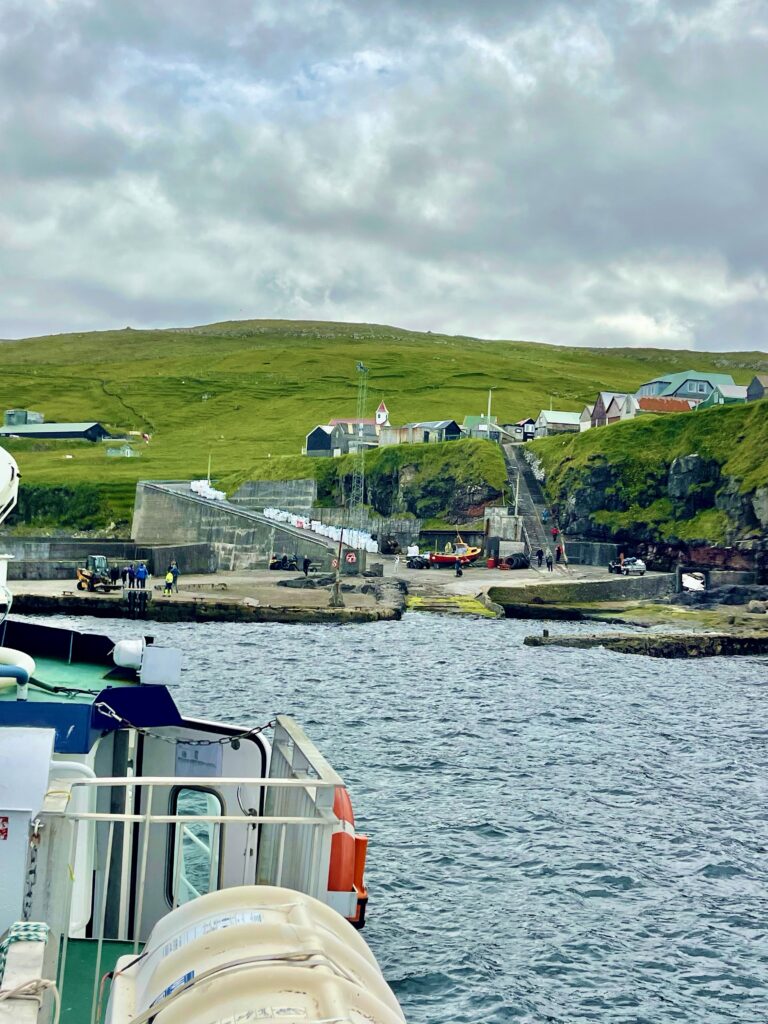
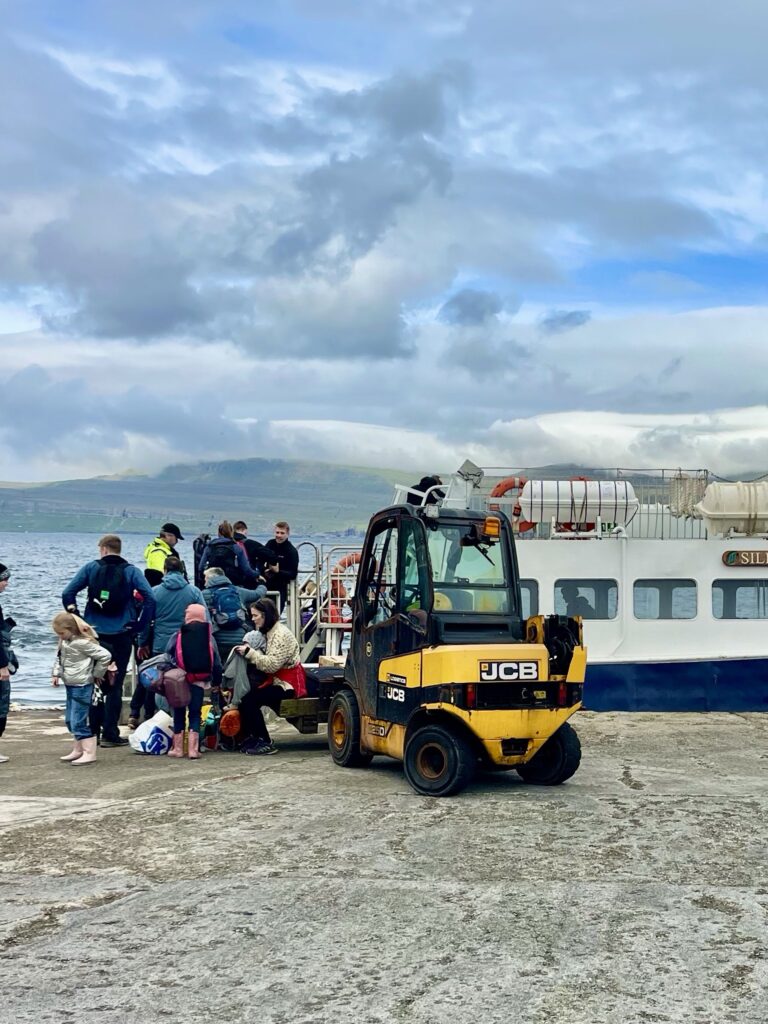

It’s the only moment, a couple of times a day, that there is real life time activity in the harbor and town, actually on the entire island. Although, behind the old church there is a helicopter port (an asphalt circle with the H on it, a windsock and a small shed to shelter

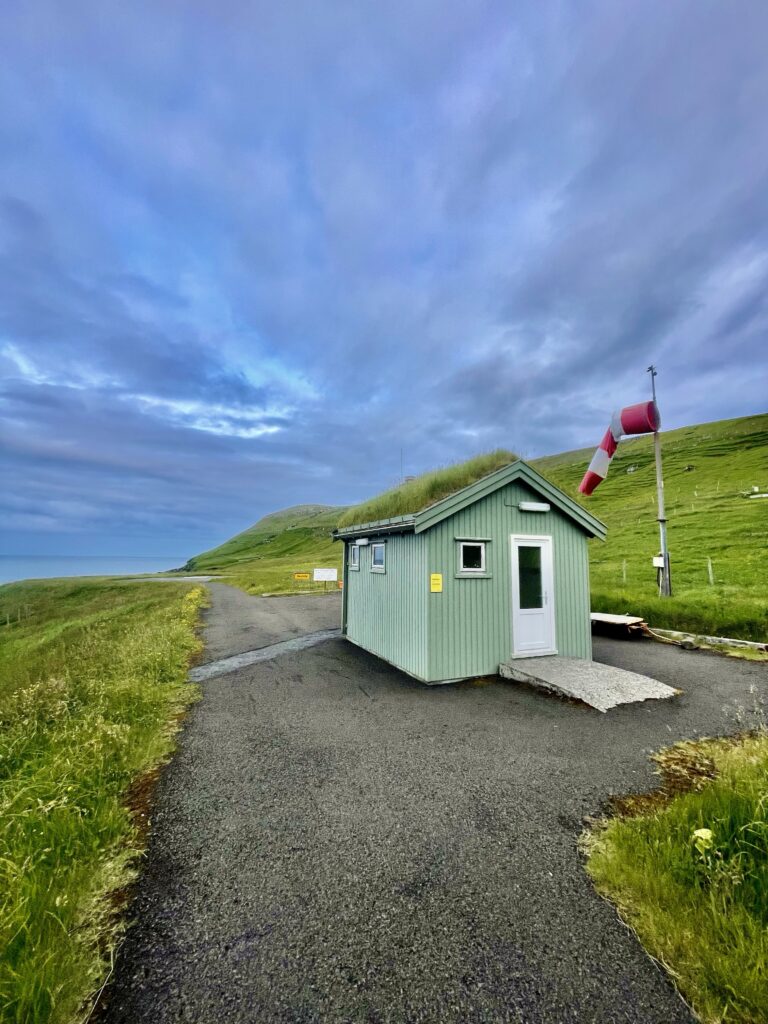
With our backpacks on our back we walked up the stairs to reach the town. We asked a local, who asked a local who asked another local where the “official” campsite was. We had heard about a spot near town where you could use the bathroom/shower in the old school. They were all surprised to hear this, and more or less unaware (yeah with less than 20 homes and only 15 inhabitants, you can off course not know everything what happens in town….). Then finally the driver of the forklift came up with his load of goods and he knew we should ask the guy with the ATV, who was bringing up the luggage of the family to “the” camping area.
Well, the camping area that was pointed out by him was situated along a small stream with fresh clean water from the hills. Actually very nice. We looked for the spot which was the most leveled and found this near a little drop off (which would be our “living room”). For the first time since many years, we were going to camp in a small tent on the ground. A big difference from the luxury of the camper truck. But, we were looking forward to it. We bought nice, very comfy sleeping bags, inflatable mattresses and pillows, had a little gas pit to make tea, coffee and warm food and even a waterfilter to purify the water.
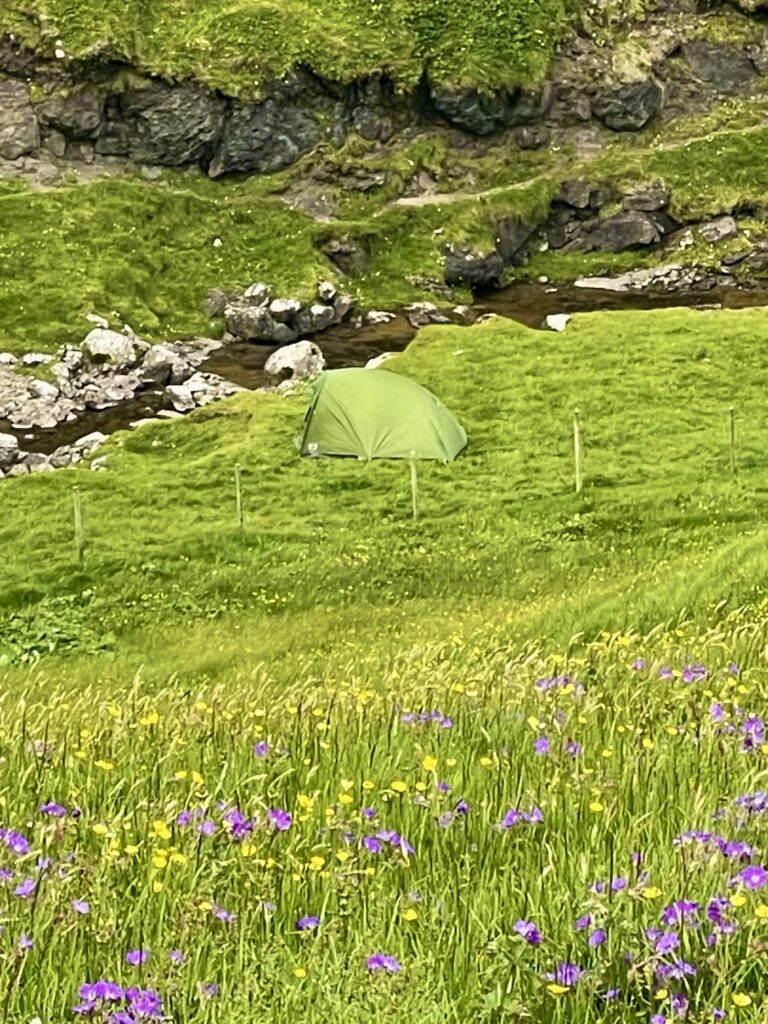
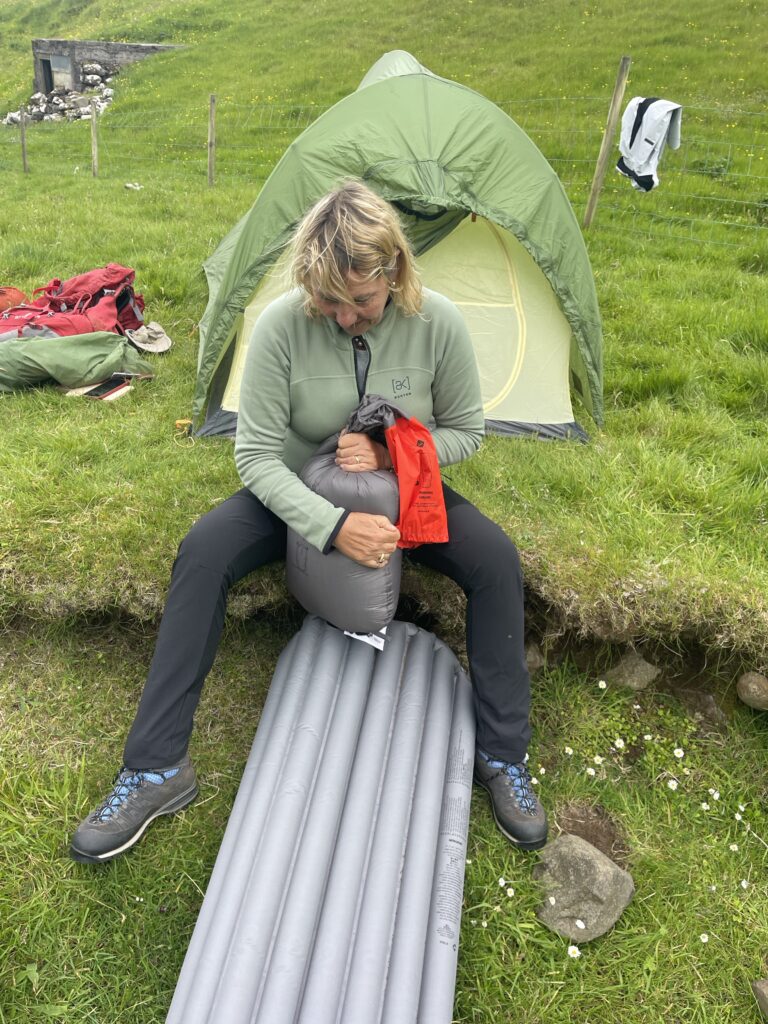
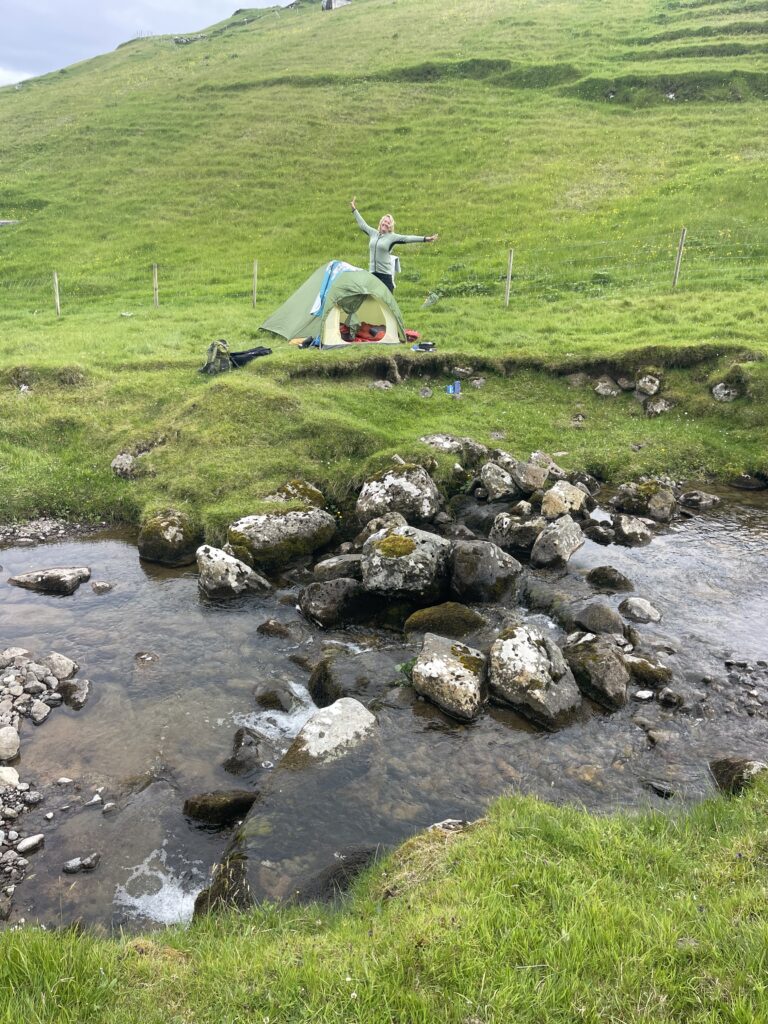
After setting up our camp (we were proud to be able to put up a tent again), we made a walk through the small town, which was separated in two by the small stream. On one side there was one house, the church, graveyard, helicopter port and an industrial building for processing the sheep wool. On the other side the rest of all the houses and the old school, which were connected by two roads. Most of the homes are second homes owned by Faroese living on other islands. It is the get-away or family holiday place.

Most homes on the Faroe Islands are not really that fancy from the outside. They are more focused on being practical due to the harsh climate and availability of construction materials. Gardening is almost non-existing, not many trees and plants survive the hard salty winds on the islands. Still we see that some islanders make it their life mission, to grow and nature some small sturdy trees and scrubs. And houses with such gardens are eye catching. Also interesting to see are the small vegetable gardens, where they just put squares of grass sods up side down and plant seeds in it, to grow the vegetables.

On our way back, we passed a house where the owner was painting his house. We started to talk and after saying we came from Sint Maarten, he knew right away about it. He had seen on internet the famous beach near the airport, where the planes fly low over to land. Even on the smallest far away places, Sint Maarten is (well) known! He asked us to have a drink and we followed him inside his house. He had bought it week ago, to make it a family house for him, his wife, 4 children and grandchildren. A get away from the busy life to where he lives (on one of the other islands, and he mentioned that his home town has less than 700 people).

We had a very entertaining afternoon with Simin (that was his name). Like a lot of islanders, he liked to have a drink together, so the table in the living room where we sat (with a great view over the rest of town and the ocean), quickly looked like a bar and filled up with empty cans and bottles. He owns a deep sea diving company, for industrial diving works (like pipe lines) and had worked all over the world. He had great stories to tell, we loved listening to him!
He asked us if we would join the bbq that evening, the mayor of the town would join as well. Of course we didn’t decline this nice invitation, although we had some doubts about the bbq (we had seen the interior of the fridge and that was practically empty!) Furthermore, there was a box with a brand new bbq outside the house, meaning, the bbq still had to be assembled. And was Simin still able to fix that?
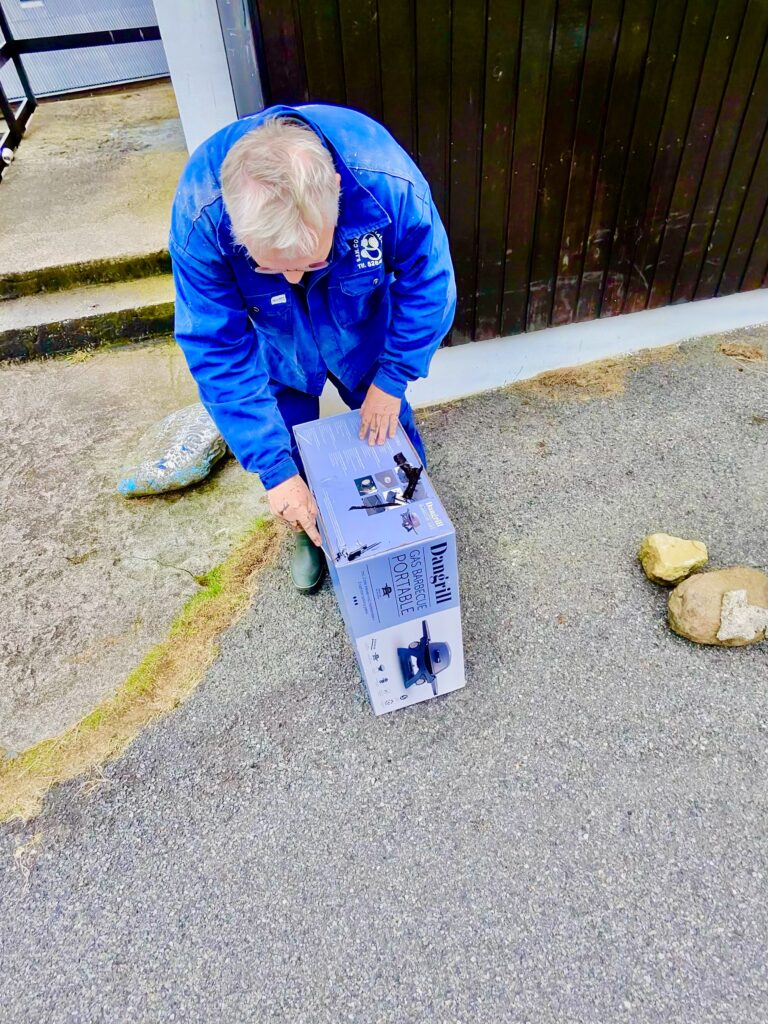
We went back to our little camp and had a quick bite (just in case our assumptions were right). We took some ready to cook meals with us and some snacks, to add to the bbq feast and to make sure there would be enough on the table to make a party!
Arriving at the house again, Simin was struggling in the kitchen to assemble the new bbq. Was an unfair fight, he was loosing it…… Looking at the large number of parts, we concluded that food would not be ready in a short moment. Simin actually came to the same conclusion, but remembered he had seen another bbq in the basement (he bought the house very recently with all the furniture). And he was right! Although not complete, with some parts of the new one, we made it work. The bbq was on!
And yes, again, our observations were right, there was not much to bbq, a bag with some ready made (only still to grill) hamburger patties was available in the fridge. So Marja started to cook the ready meals, so we could offer a little more than just the hamburger patties.
We placed the bbq outside and I took charge of grilling the hamburger patties. It all went well and when they were ready, the table looked actually like we were in for a gastronomic delight. After sitting down, we started smelling something outside and Simin discovered that he bbq was on fire! I was sure I closed of the gas bottle, but probably not completely. It was burning close to the gas hose and could have set off an explosion and most probably set the house (which Simin bought a week before our arrival) on fire. Would have been a great way to have a “house warming party” a real one! Luckily the fire was extinguished quickly.
Later on, the mayor also joined the party. The bbq night that should have started a couple of hours ago was delayed a bit by our arrival in the afternoon and the fun in the afternoon with Simon. But that did not matter, it was really pleasant!

The mayor was quite man, a man of few words. He was around his mid fifties I think, and drives around the little town with two roads, on his ATV with his two Scottish border collies in the back. Over time he has bought a lot of land on the island and he is the biggest sheep owner. Apparently he lives mostly from the trade of his wool and sheep meat. He is a man who has gone through some rough times on one of the larger islands, and decided to get away from it all, and find peace and quiet on this small island, where hardly tourists come (and I think he would like to keep it that way). As sudden as he walked in, as sudden he left the party.

When the food was finished, it was time to head back to our camp. Our first night in a small tent since many, many years. The weather was good, little wind, no rain, but still not dark. We boiled some milk for a hot chocolate.

Crawling in our sleeping bags and lying on our comfortable inflatable mattresses, we tried to get some sleep. The location of the tent was a little slanting, so during the night we were sliding down many times, since the sleeping bag and the mattress were very smooth. The fact that the tent was letting the light through, also didn’t ad to the best sleeping conditions. But, surprisingly, it was probably the sound of the running water next to the tent, we slept pretty well, although short.
After a short nights sleep, we woke up, feeling stiff as coming from under a bus and we walked to the old school to take a shower. That brought us back to life again. Marja brought really good sandwiches in our back pack and with some hot tea, we had the best breakfast on the edge of the small stream with hot coffee!

Fueled up and fired up, we prepared a small backpack to bring along on our long hike around the island of Skufoy. Since the few tourists who come on the island, are day visitors who arrive later in the morning and the family with the kids were already going back to the ferry harbor (not doing the hike), we set out all by ourselves to “discover” the natural beauty of the island.
We passed the village (we did not see Simin again, he was probably still knock out), and met the patrolling mayor with his two dogs. He pointed us to the trail, that followed at first the ATV path (there are no car sized roads on the island). Birds started to fly low over us, in an attempt to scar us away (it is nesting season) and making an ear deafening noise. Once you pass their “no go zone”, they leave you alone, until you come in the next “no go zone” and you really have to dive down many times, like if a kamikaze plane is coming down at you. Then they seem really big birds!
The Faroe Islands are hilly, very hilly, it’s like the Gods lifted large green soccer fields a mere 45 degrees up in the sky, so that their favorite team, always wins, as they can play down hill. And not only that, the ground is soggy! I On top of the rocky underground (made up from basalt rock), an approximate 50cm layer of turf with grass on top, feels like you walk on a sponge. Since it rains about 280 days of the year, the ground never really dries up, hence it stays soggy.
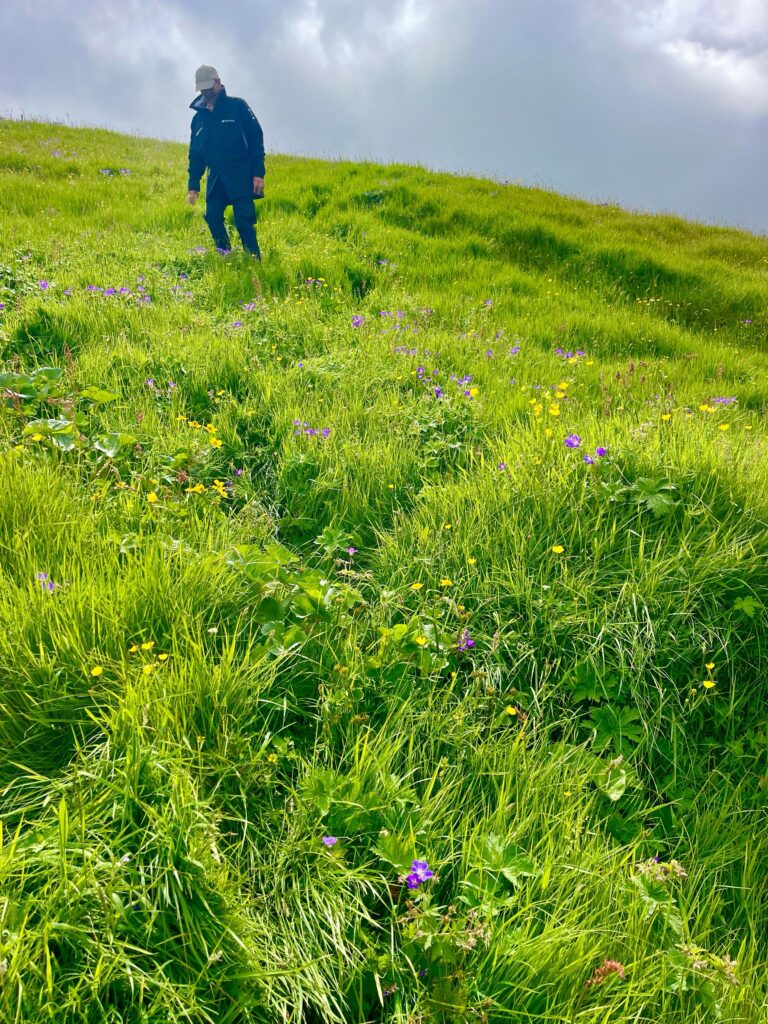
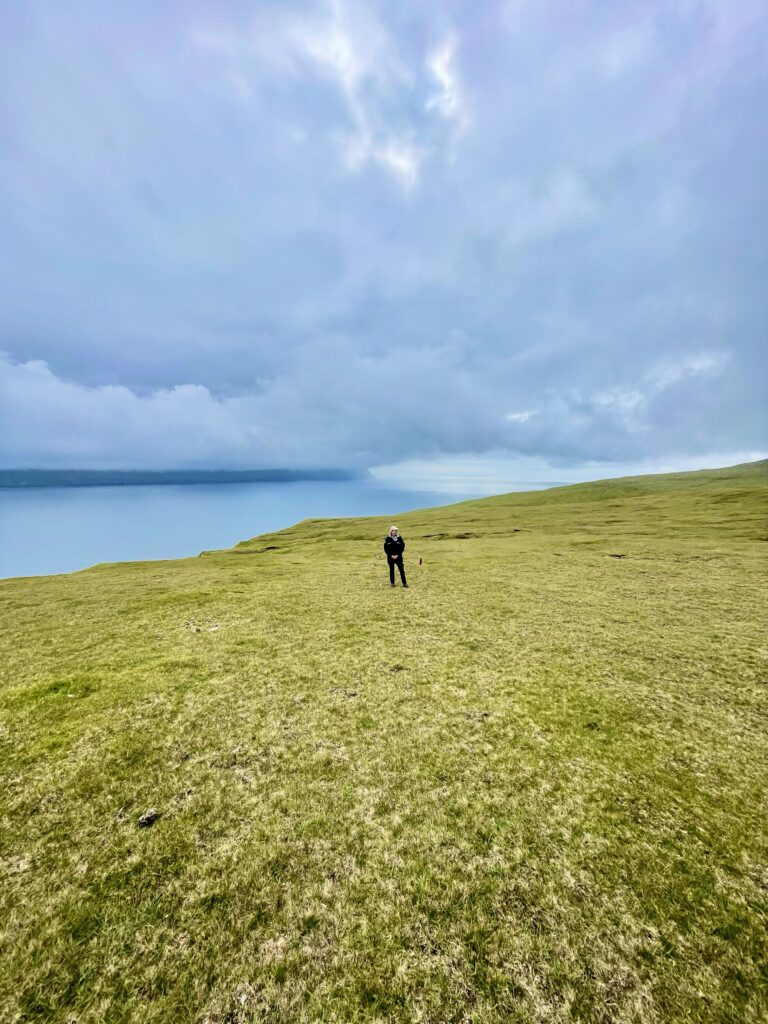
Small colored wooden sticks indicate a trail, which we follow. You walk not far from the cliff edges, but far enough not the make that one misstep and fall 400 meters down in the ocean or the rocks. The higher you get the more beautiful the scenery of the surrounding islands is. We were so luckily with the sunny sky and the absence of clouds when we walked up the trail. Hard to find words for the beauty surrounding us.

Our goal was to reach a huge cliff where the famous Puffins have a large nesting colony. After a good two hour walk, passing an impressive valley with many Faroese sheep, we reached the edges of an opposite cliff with a great view on the cliff with the nesting birds. Thousands and thousands of birds are flying up and down between the sea and the cliff. Even more are resting and nesting in the face of the cliff. Besides the Puffins there are the thousands of Seagulls and others.

The Seagulls, especially the Great Black Back Seagull, are the main enemies of the Puffins. They try to steal the catch (small fish) from the Puffins, when they fly back to their nests. Not only that, they also steal their eggs and even the just born Puffins are not safe from the Great Black Back Seagull.
Sitting on the edge of the cliff, the daily spectacle which re-occurs already for thousands of years in an (by humans) undisturbed way, manifests in front of us. A process of natural selection and a balanced eco-system, still not touched by humanity, although, it all works out as long as the Puffin can get enough food not too far from the cliffs. Overfishing and climate changes are the dangers, as warmer waters will push the primary source of food for the Puffin further up north, away from the islands.
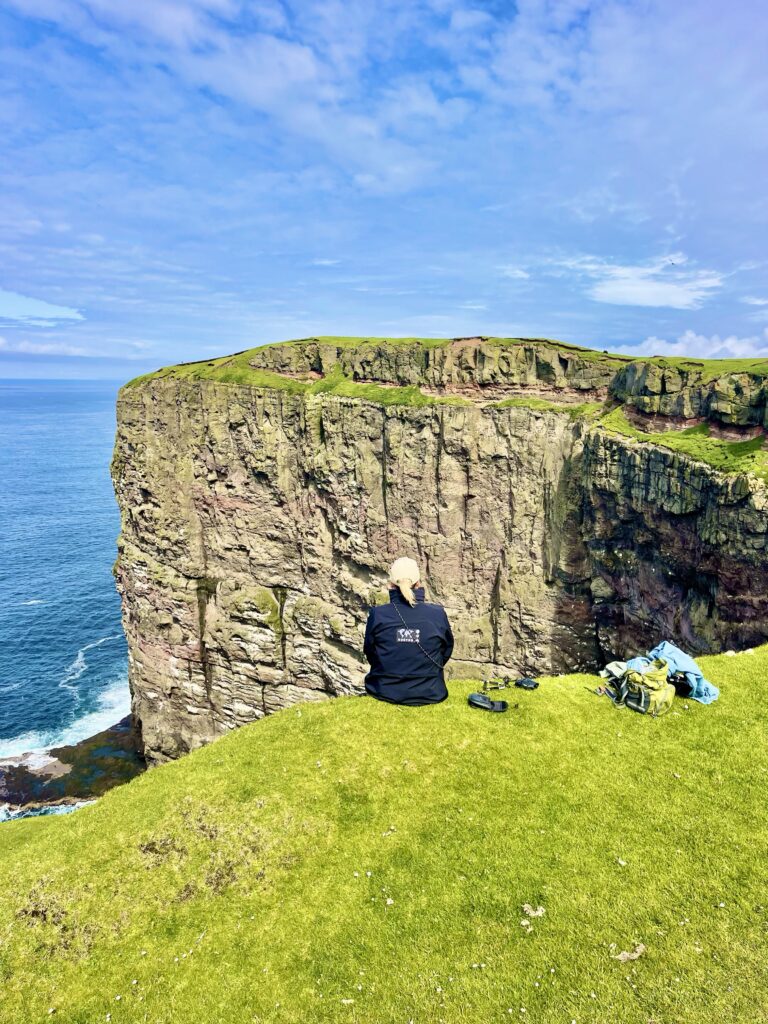

A Puffin with his beak full of small fish (sand eels, herring or capelin), was flying up and down in front of us, not knowing what to do, or maybe it found we were in his/her way. After a couple of fly-by’s the Puffin landed right in front of us, exhausted. It looked around to see if all was safe, walked up and down a few times and when it was sure we were okay, then made its final move. It dribbled towards us and right under us it disappeared in a small hole, which was where it had its nest with young. Without binoculars, we had such a good close up look on this little iconic bird. The Puffin is one of the touristic highlights when visiting the Faroes. They look so cute!

We continued our walk along the cliffs, still all by ourselves only accompanied by the occasional group of sheep. A long stretch we had to go, along a very steep mountain slope hurting our feet and ankles. Now also the fog started to climb up the cliffs and coming down over the slopes on the other side of the cliffs. It was an intriguing sight to see clouds climbing up the cliffs and making a curve going down the slope. It was really like ghosts sliding over the islands.

It is so very special to hike over these islands. Over a thousand years ago, the first people, the Vikings, landed here and started building small communities. A harsh and far away place. Generations of people have established an unique culture, cooping with the elements, living mainly from what the sea could provide and becoming a close knit community, depending mostly on each other, rather than on the outside world. (Although that is now changing fast).
We almost encircled the entire island, as we came back, close to our camp. But not before being attacked by large birds, the Arctic Skua. The moment you move, they fly straight at you, legs forward as if they want to grab you and fly very low over your head, just to scare you. In the beginning it is rather frightening, especially in the mist, when you hardly see them coming. You dive to avoid they grab your head and you keep walking until you are out of their territory. I made sure to wear a cap to protect my head! A special experience and hopefully we didn’t disturb them too much.
Reaching camp, we took a last coffee and packed up. It was a wonderful experience to have a little short get away from the camper truck and go to basic with the minimum of gear and food. Leaving behind nothing but our print in the grass, we walked back through the village towards the harbor. On our way – of course – we met the mayor again on his way to the harbor. It was his turn today to welcome the ferry, tie the ropes and help passengers off and on the ferry.
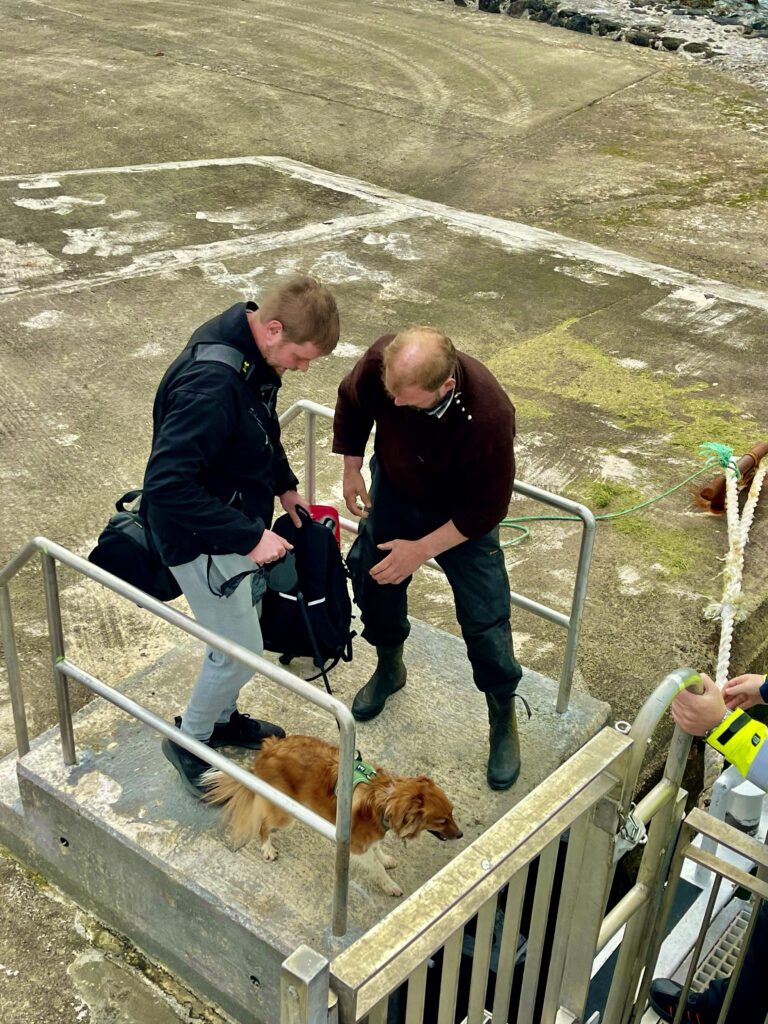
I could shake his hand one more time and got a glimpse from a smile on his face. Was not sure whether it meant like “so…”they are leaving”, or maybe “aaah, they are leaving, it was nice meeting them”…..
Think my question whether the island could or would be more developed in the future, during our bbq diner, wasn’t probably well received. Sometimes people prefer the status quo…. .and actually, yes, they might be 100% right about that.
The ferry ride back was smooth with a flat sea. Arriving back at our truck, it felt like coming home. And it was. We unpacked, cleaned up and moved the truck to a higher up place, with a view over the harbor towards the island of Skufoy….where we collected a lot of good memories again….. Simon and the mayor, thank you very much for your hospitality!

